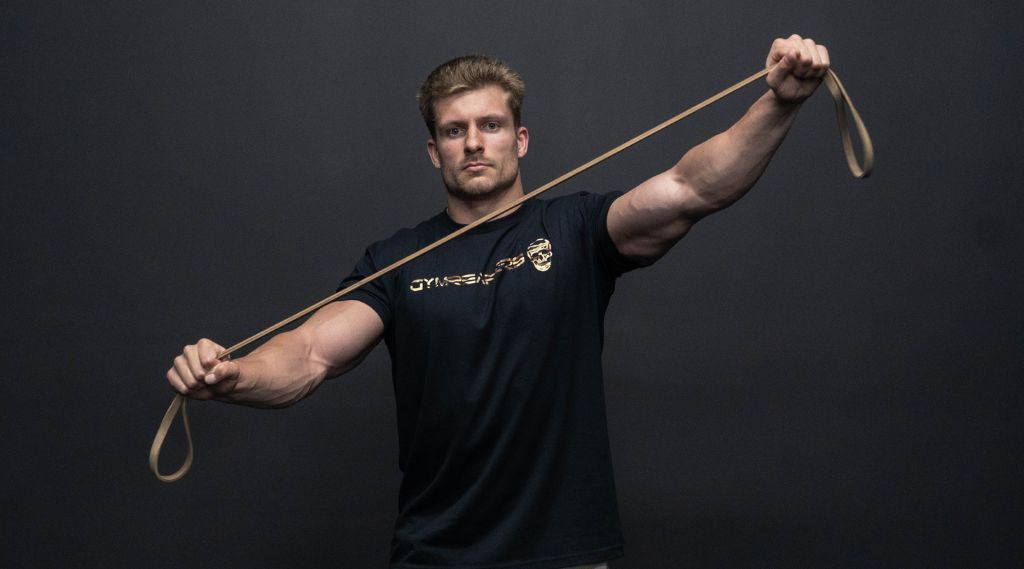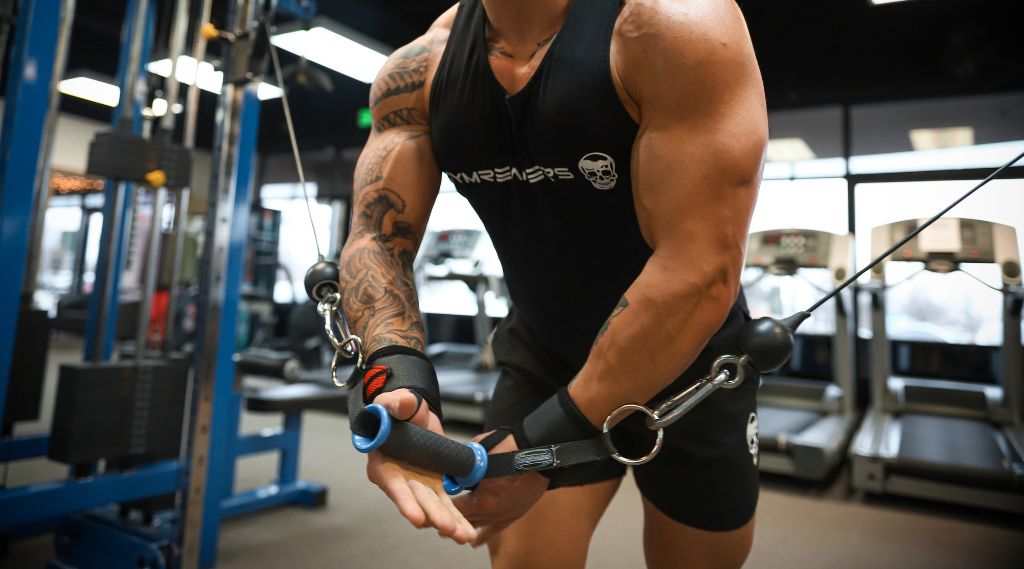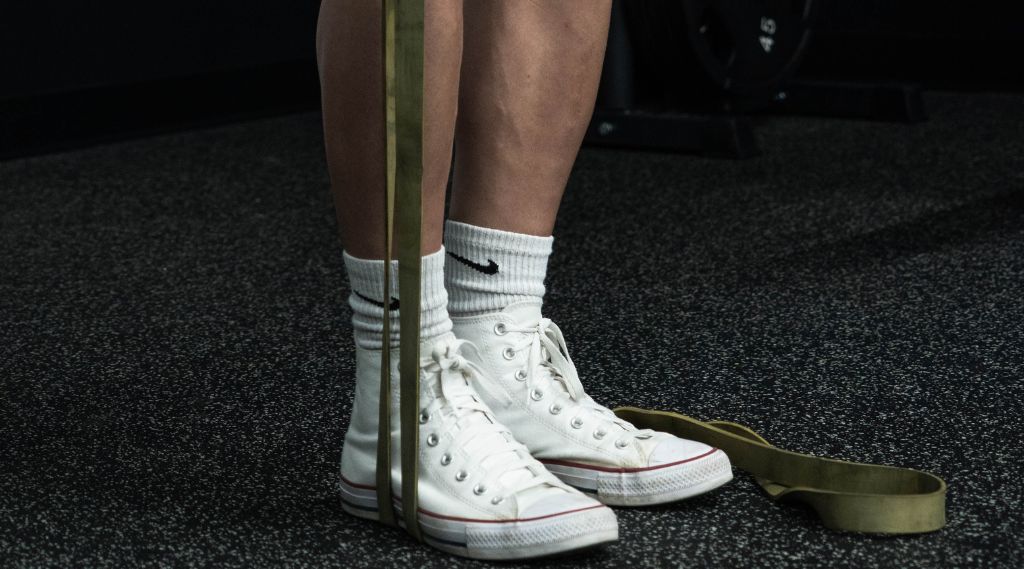Do you want to train your neck for muscle and strength gain in the privacy and comfort of your home? If so, resistance bands are one of the best tools for the job. Here’s why:
Resistance bands are ideal for neck training because they offer constant tension, increasingly more resistance toward the top of each rep, and adequate muscle overload for ongoing progress. Plus, they are easy to set up, and trainees can pick from many effective exercises to do with one or two looped resistance bands.
That said, you need to be familiar with neck muscle anatomy, what exercises to do, and how to set up and perform each activity to stay safe and minimize the risk of nagging aches or injuries.
Key Takeaways
There are more than 20 muscles in the neck. Together, they allow you to tilt your head in all directions and turn it from side to side.
Resistance bands allow trainees to safely load their neck muscles in several ways to target all the major muscles.
Getting familiar with common safety practices and picking the right resistance bands will elevate your neck training, leading to better results and lower injury risk.
Anatomy of the Neck Muscles

There are more than twenty muscles in the neck, spanning from the jaw and base of the skull to the scapula (shoulder blades) and clavicle (collarbones). Together, these muscles allow you to tilt your head forward, back, and to the sides.
Your neck muscles are also responsible for stabilizing your head, supporting your upper spine, and allowing you to turn your head in both directions.
Depending on their position, neck muscles are classified in three primary ways: anterior (front), lateral (side), and posterior (back). The position of these muscles largely determines their functions and how to train them for growth.
For instance, the deep neck flexor muscles in the front of the neck are responsible for neck flexion (bringing your chin down and toward your chest). In contrast, muscles at the back of the neck are responsible for neck extension (bringing your head back and looking up).
Lastly, we have the muscles located on both sides of the neck. These include the scalene and sternocleidomastoid muscles, which are mainly responsible for lateral neck flexion (tilting your head to the side).
Benefits of Training the Neck With Bands
Here are a few solid reasons for using resistance bands for your neck training:
-
Increasing Tension As They Stretch. As bands stretch, the resistance increases, which means each repetition gets increasingly challenging as we get closer to the top position. In the context of neck training, you can experience stronger contractions.
-
Constant Tension Throughout The Movement. Like cable machines, resistance bands offer constant tension throughout the full range of motion. As a result, you can experience greater muscle activation and see better results from your training.
-
Encourage Progressive Overload. Making your workouts more challenging is necessary for ongoing progress. A simple way to overload your neck muscles is to use a progressively thicker band as you get stronger. For instance, the lightest band in this set offers up to 35 lbs of resistance, whereas the thickest one goes up to 150 lbs.
-
Allows For Multi-Directional Exercises. Resistance bands are highly versatile because you can use them to perform many neck motions, including flexion, lateral flexion, extension, and rotation. As a result, you can train all the major muscles in your neck with a single band, leading to balanced growth and neck stability.
- Low-Stress Training. Unlike some gym exercises that can place stress on the neck and spine, resistance bands allow for smooth and controlled motions, emphasizing the muscles and reducing the risk of injury (if exercises are performed correctly).
6 Best Neck Exercises With Bands
1. Banded Neck Flexion
Band neck flexions are a simple and effective movement for training the muscles at the front of the neck. You can perform these from a standing or seated position.
How To
- Attach a looped resistance band to a sturdy object at head level. You can tie it on the upright of a squat rack or use a door anchor if you’re exercising at home.
- Grab the band, face away from the attachment point, and place it on your head (against your forehead).
- Optional: Hold the band in position with both hands.
- Take two careful steps forward to stretch the band. You should feel some tension pulling your head back.
- Stand tall, engage your abs, and flex your neck, bringing your chin down.
- Pause briefly and relax your neck as you exhale.
- Inhale again and repeat.
Pro tip: Focus on slow and controlled reps to keep the resistance band in position and prevent it from slipping up or down.
2. Banded Neck Extension
These are the very opposite of the previous movement. Performing extensions targets the posterior neck muscles.
How To
-
Tie one end of a looped resistance band on a sturdy object at head level––for example, on one upright of a squat rack.
-
Grab the band, loop it over your head, and hold it with both hands to keep it from slipping up or down.
-
Take a couple of steps back to stretch the band.
-
Engage your abs, inhale, and extend your neck, bringing your head back in one smooth motion.
-
Pause briefly and relax your head, allowing the band to pull it forward. Exhale.
- Take another breath and repeat.
Pro tip: Keep your neck aligned with your body. Avoid excessively tilting your head forward or back because that can cause unnecessary stress.
3. Banded Lateral Neck Flexion
As their name suggests, lateral neck flexions are performed by tilting your head to the left and right. These primarily train the muscles at the sides of your neck.
How To
-
Tie a looped resistance band to a sturdy object at head level. Use the upright of a squat rack or Smith machine.
-
Face sideways, grab the band, and loop it over your head. The band should be just over your ear.
-
Hold the band in position with both hands and take one or two lateral steps away to stretch the band.
-
Engage your abs, inhale, and flex your neck in the opposite direction of the attachment point to stretch the band further.
-
Pause briefly and allow the band to pull your head to the starting position. Exhale.
- Once finished training one side, rotate 180 degrees, and do the same number of reps.
Pro tip: Ease into the exercise with a light resistance band and stop if you feel persistent discomfort during or after a training set.
4. Banded Neck Rotations
Neck rotations are a slightly more advanced exercise. When done correctly, you will feel the muscles at the sides of your neck activate.
How To
-
Tie a looped resistance band to a sturdy object at head level.
-
Stand with one side facing the attachment point, grab the band, and place it over your head, just over your ear. Hold the band in position with both hands.
-
Take two to three lateral steps away to stretch the band. The band should pull your head with some force.
-
Engage your abs, inhale, and turn your head away from the resistance band.
-
Slowly return your head to the neutral position and exhale.
- Once finished turning your head to one side, rotate your body 180 degrees to do the same number of rotations in the opposite direction.
Pro tip: Use a lighter band and perform each rotation slowly and with good control. Avoid sudden jerking motions because these could put you at risk of nagging neck aches.
5. Tabletop Neck Extension
Tabletop neck extensions are a straightforward movement you can do with just a looped resistance band. These work great if you don’t have a sturdy object to tie the band around.
How To
-
Place an exercise mat on the floor.
-
Get down on your knees and prepare a looped resistance band.
-
Loop the band behind your head.
-
Lean forward and secure the band on the floor by placing both hands on it.
-
Have your arms extended, back straight, neck neutral, and knees underneath your hips. The band should pull your head down in this position.
-
Inhale and extend your neck, bringing your head up and back.
- Pause briefly and allow the band to pull your head to the starting position. Exhale.
Pro tip: You can adjust the resistance with a broader or narrower hand position. A wider position means the band is stretched to a greater degree, providing more tension. In contrast, a narrower position means you’re not stretching the band as much. Adjust based on your needs.
6. Banded Isometric Holds (Flexion, Lateral Flexion, and Extension)
Performing band isometric holds is an effective way to train your neck muscles with fewer repetitions. These can be helpful in case your neck aches from high-rep sets or if you struggle to keep the band in position against your head.
How To
- Follow the same steps as you would for each of the exercises we reviewed above. But instead of doing multiple repetitions to fatigue your neck muscles, do a single rep and hold the peak contraction for 15, 30, or even 60 seconds.
- Each static hold counts as one completed set, similar to planks, dead hangs, and other isometric activities.
Pro tip: If you are serious about neck training, consider investing money in a head harness. Having one makes it easier to attach a band in position with carabiners for a much more comfortable training experience.
Best Bands For Training Your Neck
Loop or ‘looped’ resistance bands are ideal for neck training because they are easier to secure in position. You can tie one end against a sturdy object and loop the opposite side on your head.
Also, unlike open-ended bands with handles (resistance tube design), loop bands are flat and somewhat wide, which means they are more likely to stay in position when you wrap them over your head.

To that end, I recommend checking out the military band set by Gymreapers. This set consists of five bands, each covering a unique tension range:
- Desert Tan - 20 to 35 lbs.
- OD Green - 30 to 60 lbs.
- Dark Earth - 40 to 80 lbs.
- Ranger Green - 50 to 120 lbs.
- Coyote Brown - 60 to 150 lbs.
You can pick the band that best suits your needs and gradually increase the resistance as your neck muscles strengthen. Of course, be careful not to overload your neck and sacrifice your technique. Smooth execution for more reps will generally be safer and more beneficial.
Plus, the great thing about this resistance band set is that you can use it to train all other major muscles in your body: the back, chest, shoulders, arms, lower body, etc.











Hinterlasse einen Kommentar
Alle Kommentare werden vor der Veröffentlichung geprüft.
Diese Website ist durch hCaptcha geschützt und es gelten die allgemeinen Geschäftsbedingungen und Datenschutzbestimmungen von hCaptcha.